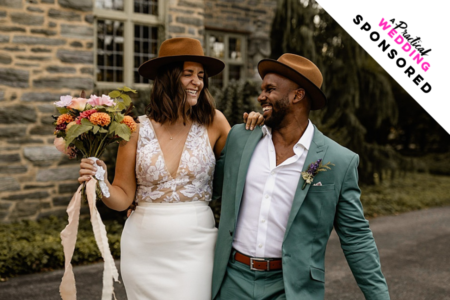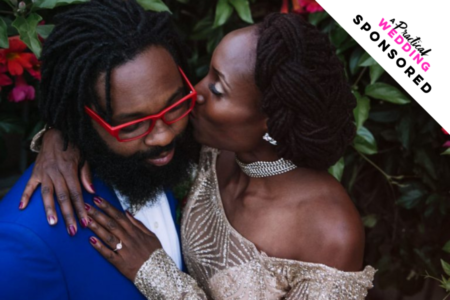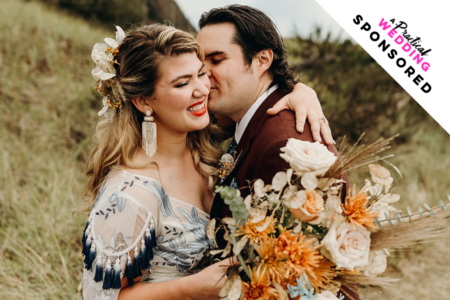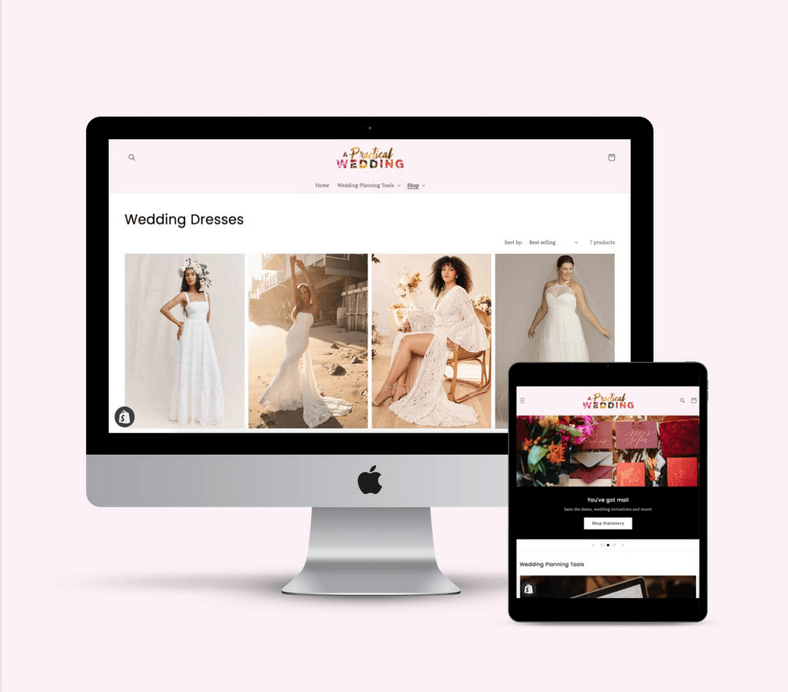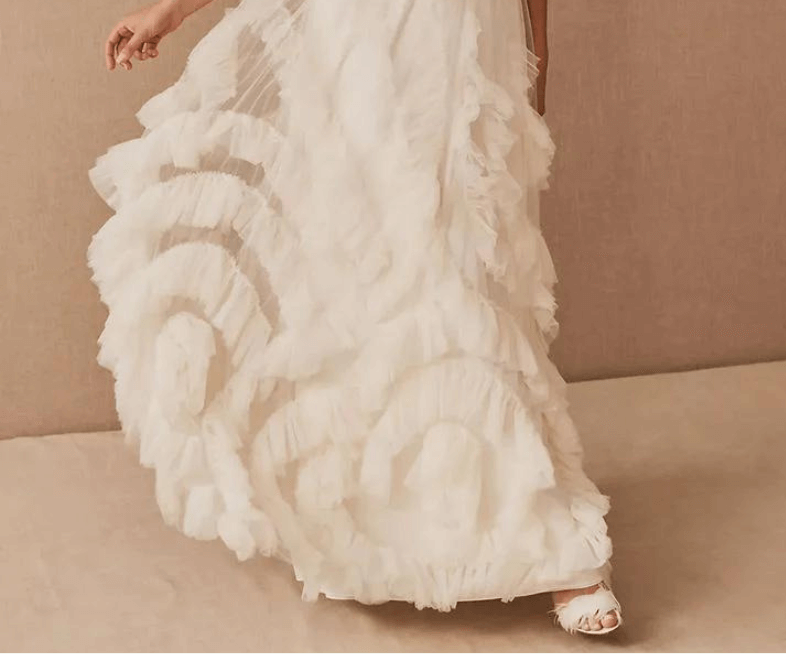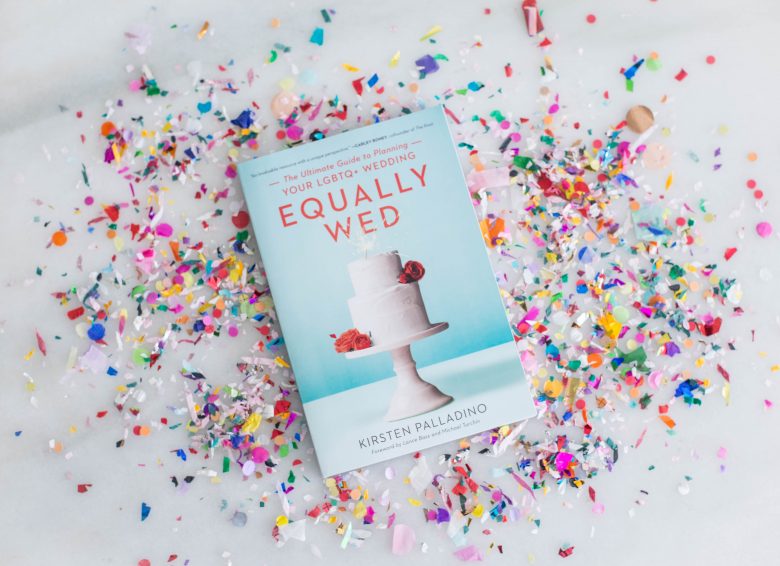
As I began planning my wedding last year, I expected to find an abundance of LGBTQ+ resources and vendor options online. Being a gay couple living in the Bay Area, we’re rarely met with anything less than acceptance, yet it quickly became apparent that the wedding industry as a whole had a lot of catching up to do. This seemed surprising since nationwide marriage equality had been the lay of the land for almost two years. I’d already been a fan of APW for years, and loved the diverse, inclusive approach to weddings. I was also looking for a space where I didn’t have to use my imagination at all. A space where I could scroll through all the content and real weddings and exclusively see my community.
Enter Equally Wed. Kirsten Palladino and her spouse, Maria, began Equally Wed in 2009 after planning their own wedding and seeing firsthand the immense problems and lack of resources members of the LGBTQ+ community were facing during wedding planning. I spoke with Kirsten about where she got her inspiration, her recently published book, and how to break down gender roles when planning a wedding.
![]()
Q: Tell me a little about yourself and your background.
A: I’ve been a professional writer and editor for fifteen years. I began my career as an art editor at a national print magazine. Since then I’ve written and edited for national and regional newspapers and magazines, as well as digital publications. I live with my spouse, Maria, and our twin six-year-old sons in Atlanta, Georgia.
Even though I’m an entrepreneur and take pride in hitting goals and continuing to challenge myself, I’m also a total dreamer, a hopeless romantic, a complete Pisces. I’m always seeking to be more mindful and self-aware, and usually I get lost in my own world, staring at the trees, the sky, life. I’m a voracious reader (lately, I’m obsessed with Lidia Yuknavitch and Roxane Gay).
Q: What inspired you to start Equally Wed and now write the book?
A: My wife proposed to me on February 29, 2008, the day before my thirtieth birthday. (I may have made some demands of a proposal before I turned thirty.) When we started planning our wedding, the first thing I did was go to my local bookstore and stock up on wedding books and magazines. I was thrilled to dive into the bridal experience that many of my straight friends had gotten to have. What happened though was soul crushing. Among the gorgeous images of multi-layered cakes, bouquets, and distinguished details were people—specifically, cisgender heterosexual people paired with people of the opposite sex. And the language! It was always “bride and groom.” And the directions for the women were all about looking as feminine and landscaped as possible on the wedding day. I wasn’t marrying a groom and she definitely has no interest in looking feminine. Basically, we just didn’t fit in. I went online and didn’t discover any modern digital resources that spoke directly to people like Maria and me.
Because I’d already been a writer and editor for seven years, and Maria had been a graphic designer and website developer for the same amount of time, we decided that we could solve the problem we saw and fill the void of LGBTQ+ couples in wedding media. Thus the launch of equallywed.com, which we launched in March 2010, with daily inspiration and information on wedding planning, tips for traveling in safe areas for LGBTQ honeymoons, proposals, fashion, and marriage equality news. We also include family features on parenting and profiles of real LGBTQ-led families under a vertical called Equally Family, and marriage and relationship advice and essays under a vertical called Equally Ever After.
It’s always been a dream of mine to have books with my name on them in the library. I’ve been working on a memoir for a few years now, and I’ve been putting together a murder mystery in my head in the last couple of years. But I’ve also been considering a book for LGBTQ+ couples, as well as something that could help the wedding industry be more inclusive and considerate of LGBTQ+ couples. For the past seven years of serving as the editor in chief of Equally Wed, I’ve thumbed through pretty much every wedding book available. Some have sweetly mentioned gays and lesbians with a nice little shout-out about how we can do the mental gymnastics and then be able to use the advice for ourselves. Actually, what they say is that everything totally applies to us. But it doesn’t. It “totally” doesn’t. Telling us that using “bride and groom” applies to us is erasing our queer experience, the hardships we endure, the fight we’ve waged to arrive at marriage equality, the challenges we face every time we call for an appointment with a wedding vendor and even in our own families. For the most part, the language in these books (and magazines and websites) assumes that the marriers are straight, with pages devoted to all things bridal—and that’s just one bride, of course.
Then there are the three or so traditionally (not self-published) wedding books for same-sex couples. And those, for the most part, are again solely for cisgender lesbians and gays. When it’s two women, the authors refer to them as two brides and she/her/hers pronouns, and the same for two men, who are assumed to be two grooms and identifying with he/him/his pronouns. But our community is more than that. We’re not all gay or lesbian, and we’re certainly not all cisgender. But I wasn’t seeing the rest of our community well represented in wedding books, not as the standard, the norm, the majority.
I wanted a book just for us, where we don’t have to wonder where we fit in. So I wrote one.
Q: While much progress has been made since Equally Wed’s inception, why do you feel that LGBTQ+-specific sites are still important and needed?
A: You’re right: We’ve had so much progress. When Maria and I launched Equally Wed in 2010, only six states had marriage equality. And while websites and magazines have become more inclusive of same-sex couples (but usually not acknowledging queer or trans people), I’m certain that now more than ever before we need to continue to have our own safe places for information, support, and inspiration. The LGBTQ+ community intersects with many other communities—of color, of faith, of hobbies, and of geography. But in our own pride-filled community we don’t have to continuously come out as LGBTQ+ to each other, we can feel at ease to just simply be ourselves, to not worry about judgment, discomfort, or intolerance. As long as we’re a marginalized community, we need specific sites and places that are devoted to just us and operated by us. That’s why there are sites for Jewish weddings, for Indian weddings, for black weddings, etc.
Q: Equally Wed is clearly geared toward folks in the LGBTQ+ community. But can straight folks read this, too? What can they get out of it?
A: Absolutely. Straight folks are welcome in the Equally Wed community. While we cover a variety of challenges faced by LGBTQ+ people that straight people are privileged to usually not have to worry about, there are takeaways for everyone. Speaking to your family members about a wedding they might not be too thrilled about, broaching the topic of money and if anyone wants to help pay for the wedding, ways in which to walk down the aisle and who can do it (everyone!). And of course, we strive for equality in weddings in every way, so we hope to give people plenty to think about in terms of removing gender assumptions about either of the marriers. One of the largest group of straight readers we have are wedding industry professionals who come to Equally Wed to learn about being more equality-minded and inclusive in their interactions with LGBTQ+ couples as well as in their marketing and their contracts.
Q: Probably one of the very best parts of Equally Wed, and something I appreciate about it, is that it’s written to a gender-neutral reader. Why did you feel this was important?
A: I care very much about nonbinary and gender nonconforming people. They’re left out by society, from bathrooms to checking off a gender box that doesn’t apply to them on every single form in every single place online and in person. It can feel isolating. And I don’t believe that society should be like that. I want us to move beyond the gender construction that society has created—where we’re free to be you and me without the assumption of gender (and all of the expectations that lurk like a shadow over each gender). I’m not saying that we should get rid of female and male identities altogether. I just want to make space for people who don’t identify as either of the two most common genders, male and female, or identify as both or more. When we do that—move away from society’s current understanding of gender—we’ll be freeing ourselves from the assumptions that sit on the shoulders of the male and female genders. Expecting people to behave, look, and think a certain way because of their perceived or known gender is preposterous. And I’m pretty much done with that way of thinking. I wanted to write a book that offers advice on gown or suit shopping, bouquet carrying, boutonnière wearing, proposal asking, ring buying, and name changing all without the assumption that the person who will be doing it is of a certain gender. Gender doesn’t have to be a part of that discussion, of wedding planning.
Q: You talk a lot about the importance of vetting your vendors. Having planned my own gay wedding, we focused on working with vendors in the community or female-owned businesses. But even the most well-intentioned vendors we felt were lacking when it came to inclusivity. For example, their forms or websites just said “bride and groom.” What’s your best advice for vendors who want to work with all types of couples?
A: Congratulations on your wedding and marriage! I hear what you’re saying. In fact, I hear it all the time. Female-owned businesses unfortunately don’t perform any better than male-owned businesses when it comes to inclusiveness. It really comes down to allies who not only are willing to work with us but who openly want to celebrate us and learn how to best include us. At Equally Wed, we operate an education arm to wedding industry pros to become more equality-minded, from on-site training to consultations about their marketing and contract language. I advise wedding pros to get rid of “bride” and “groom” from all of their communications: from their website, their brochures, their wedding shows, their mouths, even their inner dialogue. Start using gender-neutral language everywhere. Call your couples nearlyweds, marriers, celebrants, or clients. It takes nothing away from your cisgender heterosexual clients and gives so much to potential LGBTQ+ clients.
Q: One of the topics your book covers is how to deal with homophobic or transphobic family members, a question we often get here on APW as well. Is that something you had to personally deal with?
A: I’m not in a place in my life where I can elaborate, but the short answer is yes, and it was a major impetus for the creation of Equally Wed.
Q: What is the best piece of wedding planning advice you’ve ever gotten? What is the worst piece of wedding planning advice you’ve ever gotten?
A: The best wedding advice I received when we were planning our wedding was to not invite anyone who I didn’t see in my life beyond the next five years. It really helped us whittle down our guest list!
Ah, the worst? I think that the idea that you “must do X” or that you simply “have to have Y” is bullshit. My entire book is just suggestions. The only rule I have is that you send handwritten thank-you notes for every gift and assistance you receive.
Q: Since you work in the industry, when you go to a wedding, are you in editor/advice mode? Or are you able to relax and enjoy the day?
A: For the most part, I really relax and enjoy the day. I certainly take mental notes of elements I love and might cover in the future, but I’m a total romantic sap. I get caught up in the joy of the moment, cry tons of happy tears, and have fun.
Q: What’s next for you and Equally Wed? Do you have plans for any more books?
A: We’re amping up our educational and diversity training services for the wedding industry and expanding our editorial team to increase our daily content to even higher frequency. I have a few book proposals and half-written manuscripts in the works. I’ll keep you posted!
Q: Thank you Kirsten for the work you’re doing! I loved being able to read through a book and know it was entirely written for folks just like me. It’s so refreshing to not have to mentally replace words, or read asides about how gay folks can adjust it to make it their own, etc. Your site was a great resource for me and my wife, along with A Practical Wedding, so I’m glad there’s a book now too for couples planning their weddings!
A: Thank you so so so much for sharing this with me, Kate! I really appreciate it and happy that you connect with the book and the site!
![]()
check out equally wed for more lgbtq+-related content and be sure to pick up a copy of kirsten’s book!

